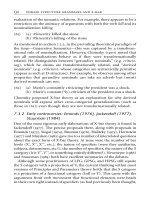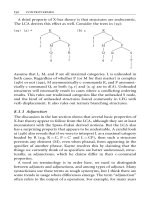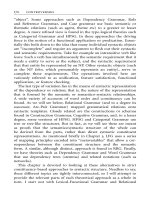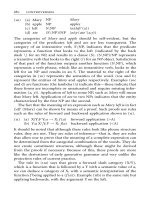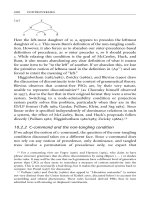Tài liệu Constituent Structure - Part 2 doc
Bạn đang xem bản rút gọn của tài liệu. Xem và tải ngay bản đầy đủ của tài liệu tại đây (69.88 KB, 10 trang )
Acknowledgements
This book has beneWted from the input, advice, and feedback
from a number of people, ranging from answering simple email quer-
ies to reading all or some of the manuscript. Here’s a partial list,
in alphabetical order: Anne Abeille
´
, Ash Asudeh Andy Barss,
Bob Berwick, Tom Bever, Sherrylyn Branchaw, Jean Carnie, Fiona
Carnie, Morag Carnie, Robert Carnie, Robert Chametzky, Noam
Chomsky, John Davey, Andrea Dauer, Malcolm Elliott, Yehuda Falk,
Georgia Green, Heidi Harley, Michael Hammond, Richard Hudson,
Peter Kahrel, Tibor Kiss, Simin Karimi, Tracy Holliway King, Terry
Langendoen, Shalom Lappin, Howard Lasnik, Tel Monks, David
P. Medeiros, Stefan Mu
¨
ller, David Pesetsky, Massimo Piatelli-Palmar-
ini, Chloe Plummer, Carl Pollard, GeoV Pullum, Sumayya Racy, Ivan
Sag, Maggie Shade, Yosuke Sato, Robert Van Valin, Steve Weschler.
Thanks to you all. Special thanks go to my family who let me work on
this book while ignoring them over the 2006 winter holidays.
AC
Tucson, February 2007
General Preface
Oxford Surveys in Syntax and Morphology provides overviews of the
major approaches to subjects and questions at the centre of linguistic
research in morphology and syntax. The volumes are accessible, crit-
ical, and up-to-date. Individually and collectively they aim to reveal
the Weld’s intellectual history and theoretical diversity. Each book
published in the series will characteristically contain: (1) a brief histor-
ical overview of relevant research in the subject; (2) a critical presen-
tation of approaches from relevant (but usually seen as competing)
theoretical perspectives to the phenomena and issues at hand, includ-
ing an objective evaluation of the strengths and weaknesses of each
approach to the central problems and issues; (3) a balanced account of
the current issues, problems, and opportunities relating to the topic,
showing the degree of consensus or otherwise in each case. The
volumes will thus provide researchers and graduate students con-
cerned with syntax, morphology, and related aspects of grammar,
communication, and cognition w ith a vital source of information
and reference.
Andrew Carnie’s Constituent Structure surveys one of the most
fundamental areas of syntax. It encompasses a variety of views and
proposals, both within the Chomskyan tradition and outside of it, and
in this regard it is a quite unique and valuable contribution to the
study of syntax.
Robert D. Van Valin, Jr
General Editor
University at BuValo, The State University of New York
Heinrich Heine University, Du
¨
sseldorf
Abbreviations
3rd third person
A movement Argument movement (same as NP movement)
A answer
A-bar movement non-argument movement (typically the same as
wh-movement)
Adj’ ‘‘Adjective bar’’, intermediate adjective category
Adj Adjective
AdjP Adjective Phrase
Adv’ ‘‘Adverb bar’’, intermediate adverb category
Adv Adverb
AdvP Adverb Phrase
AFD in RRG, actual focus domain
agreement agreement feature
AgrIO Indirect object functional projection
AgrIOP Indirect object Agreement Phrase
AgrO Object agreement functional projection
AgrOP Object agreement Phrase
AgrS Subject agreement functional projection
AgrSP Subject agreement Phrase
ARG in RRG, arguments
Aux Auxiliary
AVM attribute value matrix
bar bar-level feature
BPS Bare Phrase Structure
C’ ‘‘Complementizer bar’’, intermediate complemen-
tizer category
C Complementizer
category category feature
CF context free
cho
ˆ
cho
ˆ
meur (relational grammar)
comps complement feature
Condition A the requirement that an anaphor must be bound in
a local domain
Condition B the requirement that a pronoun must not be
bound in a local domain
Condition C the requirement that an R-expression must not be
bound
Conj Conjunction
COP copula
CP Complementizer Phrase (¼ S’)
CS context sensitive
D’ ‘‘Determiner bar’’, intermediate determiner
category
D Determiner
DAG directed acyclic graphs
def deWniteness
DOM Domain-of-word-order feature in HPSG
DP Determiner Phrase
DTRS daughters feature in HPSG
ECPO Exhaustive Constant Partial Ordering
EPP Extended Projection Principle
EST Extended Standard Theory
FCR Feature Co-occurence Restriction
FFP Foot-Feature Principle
fin Finite
Foc Focus
FSA Wnite-state automata
FSD feature-speciWcation defaults
GB Government and Binding Theory
gender gender feature
GKPS Gazdar, Klein, Pullum, and Sag ( 1983)
GPSG Generalized Phrase Structure Grammar
GT generalized transformation
HFC Head Feature Convention
HPSG Head-driven Phrase Structure Grammar
IC immediate constituent
ID/LP immediate dominance/linear precedence
IDC immediate dominance c-command
IF in RRG, Intentional Force
InX the functional category of InXection, later
replaced by Agr, AgrS, AgrO, TP
inv inversion feature
IP InXectional Phrase (often the same as TP or S)
label set of category labels
abbreviations xiii
LCA Linear Correspondence Axiom
LCS in RRG, the layered structure of the clause
LF Logical Form
LFG Lexical-Functional Grammar
LSLT Logical Structure of Linguistic Theory
M mothership relation/immediate domination
max set of XP categories
MP Minimalist Program
MSO Monadic Second Order
MTS Model-Theoretic Syntax
MUB Minimal Upper Bound
N’ ‘‘Noun bar’’, intermediate noun category
N Noun
Neg Negation
NP Noun Phrase
NUC in RRG, the nucleus of the CORE
num number feature
obj in LFG, object function
OSV Object-Subject-Verb order
OVS Object-Verb-Subject order
P’ ‘‘Preposition bar’’, intermediate preposition cat-
egory
P Preposition
P&P Principles and Parameters Theory
person person feature
PF Phonetic/Phonological Form
PFD in RRG, potential Focus Domain
PM phrase marker
PP Prepositional Phrase
PRED in RRG, the predicate; in LFG, the predicative
content of the f-structure
PSG phrase structure grammar
PSR phrase structure rule
Q Question
QP QuantiWer Phrase
R-expression referring expression (most nouns, excluding pro-
nouns, anaphors, and other elements that typically
get their reference from linguistic context)
RG Relational Grammar
xiv abbreviations
RRG Role and Reference Grammar
S Sentence (often ¼ IP or TP)
S’ ‘‘S-bar’’ (¼ CP)
SAI Subject-Aux Inversion
SCT structure-changing transformation
slash ‘‘slash feature’’ (indicates a gap in structure)
SOV Subject-Object-Verb order
subcat subcategorization feature
subj in LFG, subject function
SVO Subject-Verb-Obje ct order
T’ ‘‘Tense bar’’, intermediate tense category
T Tense functional projection
TAG Tree-Adjoining Grammar
TG Transformational Grammar
Tns in RRG, tense
Top Topic
TP Tense Phrase (often the same as S)
UB upper bound
v ‘‘little v’’ or ‘‘light v’’
V’ ‘‘Verb bar’’, intermediate verb category
V verb
VOS Verb-Object-Subject order
vP ‘‘little v’’ phrase
VP Verb Phrase
VPISH VP-internal Subject Hypothesis
VSO Verb-Subject-Object order
X’ some intermediate category headed by category X
X’’ ‘‘X double bar’’, usually equivalent to XP or X
max
X
o
head (word) indicating category X
xcomp in LFG, predicate complement
X
max
maximal (usually phrasal) category associated
with category X, usually equal to X’’ and XP
X
P
a node of cate gory X, of indeterminate phrasality
XP some maximal/phrasal category headed by cat-
egory X, often equivalent to X’’ and X
max
abbreviations xv
Symbols Used
# Before an example sentence, indicates semantic oddity
Or pragmatic infelicity.
& Conjunction (and)
_ Disjunction (or)
: Negation (‘‘it is not the case that’’)
! Two uses: (a) in logical formula: conditional (if
then); (b) in phrase structure grammars ! means
‘‘rewrites as’’, ‘‘projects from’’, ‘‘consists of ’’ or ‘‘is li-
censed by’’, depending upon the approach.
$ Biconditional (if and only if)
8 Universal quantiWer (every)
9 Existential quantiWer (some)
List addition
() In phrase structure rules indicates optionality. In syn-
tactic forms may indicate structure. In logical forms
may indicate functional application or structure, as in
the usual usages.
("subj)¼# In LFG, metavariable indicating node bears subject role
of dominating category (similarly for (" obj)¼#, etc.)
"¼# In LFG, metavariable indicating featural identity be-
tween node and dominating category
* Kleene star. In phrase structure rules, indicates zero or
more. Before an example, indicates ungrammaticality.
/ _____ In phrase structure rules, ‘‘_____ is in the context of’’
? Before an example sentence, indicates marginal gram-
maticality.
[] Constituent boundaries
^ Span; in the right-wrap rule, indicates linear concaten-
ation
{NP/CP} In phrase structure rules, indicates choice between NP
and CP.
{x, y} Unordered set of x and y
j Such that (in set descriptions); boundary in immediate
constituent analysis
Approximately
þ Kleene plus. In phrase structure rules, indicates one or
more. In other contexts, indicates addition.
<A Rule of Backward Application (Combinatorial Categor-
ial Grammar)
hx, yi Ordered set of x and y
Precedence
s
Sister precedence
¼ Equals
¼
def
Is deWned as
> Greater than
>A Rule of forward application (Combinatorial Categorial
Grammar)
+ Plus or minus in binary feature values
2 Element of (set membership)
[ Set union
‘‘Is a’’ relation
6¼ Does not equal
# Lesser than or equal too
$ Greater than or equal to
Used in feature coocurrence restrictions (FCRs) for
‘‘entails’’ or ‘‘requires’’
/ Immediate domination
/* Domination
/
þ
Proper domination
) In TG, this indicates a structure changing transform-
ation; in GPSG it indicates the application of a meta-
rule or a meaning postulate.
a, b, c, . . . Constants
i, j, k, l, . . . Indices
w, x, y, z, . . . variables
N Set of non-terminals
NP# Substitute an NP in this position. (Tree-Adjoining
Grammar)
P Set of production rules
S Star t symbol
S/NP In Combina torial Categorial Grammar, look right for
an NP to form an S.
S\NP In Combinatorial Categor ial Grammar, look left for an
NP to form an S.
symbols xvii
T Set of terminals
ºx Lambda operator (indicates following string is an open
function unspeciWed for x)
P Projection path
SP Polarity Phrase
xviii symbols
Proper words in proper places . . .
Jonathan Swift, Letter to a Young Clergyman, 9 January 1720


